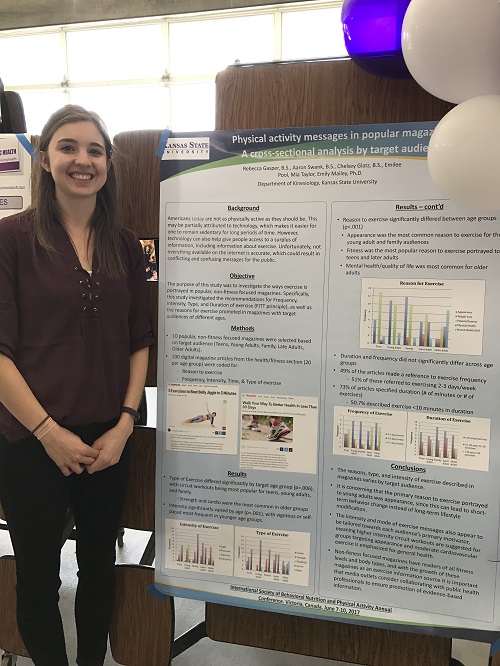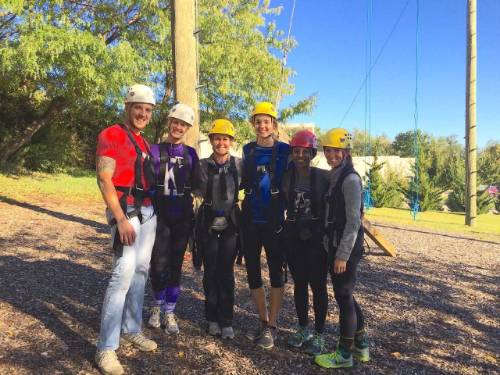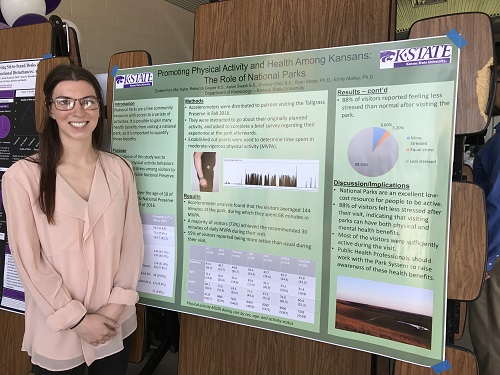Physical Activity Intervention Research Laboratory (PAIR Lab)
Director: Dr. Emily Mailey
Lab Overview
The mission of the Physical Activity Intervention Research Laboratory (PAIR Lab) is to develop and deliver interventions to promote physical activity and reduce sedentary behavior in a variety of populations. The PAIR Lab focuses on teaching individual behavior change strategies and developing support systems to enhance adoption and maintenance of physical activity. In addition, studies examine the social and psychological factors that influence physical activity participation, as well as the influence of physical activity participation on physical and mental health outcomes that impact quality of life. A core goal of the PAIR Lab is to design effective, sustainable interventions that can be adopted and implemented in various settings to have a significant public health impact.
Learn more about the PAIR Lab's current projects.
Areas of Research Focus
Intervention studies
The PAIR Lab interventions have targeted a variety of populations, including working mothers, new mothers, military spouses, and office-based employees. These studies have utilized both face-to-face and web-based delivery methods to provide behavioral support to promote physical activity in individuals and groups. Read about the results of these studies here:
- Mailey, E. L., Rosenkranz, R., Rosenkranz, S. K., Ablah, E., Talley, M.*, Biggins, A., Towsley, A., & Honn, A. (2022). Reducing occupational sitting while working from home: Individual and combined effects of a height-adjustable desk and an online behavioral intervention. Journal of Occupational and Environmental Medicine, 64(2), 91-98.
- Mailey, E. L., Garcia, J., & Rosenkranz, R. R. (2021). A brief staff training to increase children’s physical activity during an after-school program: Preliminary effectiveness and potential for dissemination. Journal of Healthy Eating and Active Living, 1(2), 74-83.
- Mailey, E. L., Irwin, B. C., Joyce, J. M., & Hsu, W. (2019). InDependent but not Alone: A web-based intervention to promote physical and mental health among military spouses. Applied Psychology: Health and Well-Being, 11(3), 562-583. doi: 10.1111/aphw.12168
- Mailey, E., & Hsu, W. (2017). Is a general or specific exercise recommendation more effective for promoting physical activity among postpartum mothers? Journal of Health Psychology. doi: 10.1177/1359105316687627
- Mailey, E. L., Rosenkranz, S. K., Ablah, E., Swank, A., & Casey, K. (2017). Effects of an intervention to reduce sitting at work on arousal, fatigue, and mood among sedentary female employees: A parallel-group randomized trial. Journal of Occupational and Environmental Medicine. doi: 10.1097/JOM.0000000000001131
- Mailey, E. L., Rosenkranz, S. K., Casey, K., & Swank A. (2016). Comparing the effects of two different break strategies on occupational sedentary behavior in a real world setting: A randomized trial. Preventive Medicine Reports, 4, 423-428. doi: 1016/j.pmedr.2016.08.010
7. Mailey, E. L., Huberty, J. L., & Irwin, B. C. (2016). Feasibility and effectiveness of a web-based physical activity intervention for working mothers. Journal of Physical Activity and Health, 13(8), 822-829. doi: 10.1123/jpah.2015-0643
Behavioral determinants of physical activity
Our lab has also done research to better understand physical activity motivation, barriers and facilitators among parents and military spouses. In particular, we are interested in using a self-determination theory lens to examine optimal goals and motives for sustained physical activity participation. Read about this work here:
- Mailey, E. L., Dlugonski, D., Hsu, W., & Segar, M. (2018). Goals matter: Exercising for well-being but not health or appearance predicts future exercise behavior among parents. Journal of Physical Activity and Health, 15(11), 857-865. doi: 1123/jpah.2017-0469
- Mailey, E. L., Mershon, C., Joyce, J., & Irwin, B. (2018). “Everything else comes first”: A mixed-methods analysis of barriers to health behaviors among military spouses. BMC Public Health, 18, doi: 10.1186/s12889-018-5938-z
- Mailey, E. L., Phillips, S. M., Dlugonski, D., & Conroy, D. E. (2016). Overcoming barriers to exercise among parents: A social cognitive theory perspective. Journal of Behavioral Medicine, 39(4), 599-609. doi: 1007/s10865-016-9744-8
- Mailey, E., Huberty, J. L., Dinkel, D., & McAuley, E. (2014). Physical activity barriers and facilitators among working mothers and fathers. BMC Public Health, 14, 657. doi:10.1186/1471-2458-14-657
Physical activity messaging and promotion
Our lab has been studying the media’s approach to promoting physical activity, and how both children and adults view exercise. A core goal of this line of research is to develop and test strategies for updating physical activity messages to facilitate autonomous motivation by aligning with individuals’ core values.
- Mailey, E. L., Montney, J.*, Talley, M.*, Sanders, C.*, Garcia, J.*, Stephens, S.*, & Dlugonski, D. (2022). How do youth perspectives on physical activity differ across childhood? Leisure Studies.
- Mailey, E. L., Dlugonski, D., Besenyi, G., Gasper, R*, & Sloane, S. (2022). Effects of a single message exposure on exercise motivation and behavior among adults aged 30-45. International Journal of Health Promotion and Education, 61(2), 83-97.
- Mailey, E. L., Gasper, R., Dlugonski, D., & Besenyi, G. (2020). Promoting strength training among Baby Boomers: Message framing effects on motivation and behavior. International Journal of Behavioral Medicine. doi: 1007/s12529-020-09939-9
- Mailey, E. L., Gasper, R., & Dlugonski, D. (2019). Why and how should I exercise? A content analysis of popular magazines. American Journal of Health Behavior, 43(2), 349-360. doi: 5993/AJHB.43.2.11
Integrating physical activity promotion into mental healthcare
An emerging area of interest in the PAIR Lab is the integration of physical activity promotion into mental healthcare. Specifically, we are developing training for mental health providers to discuss and recommend outdoor physical activity as part of their clients’ treatment plans. We have conducted formative research with both therapists and clients to inform these efforts.
- Mailey, E. L., Besenyi, G. Montney, J.*, & Durtschi, J. “Make it about my mental health”: Clients’ recommendations for discussing physical activity during therapy. Poster presented at the annual meeting of the Society of Behavioral Medicine, Phoenix, AZ, April 2023.
- Mailey, E. , Besenyi, G., & Durtschi, J. (2022). Mental health practitioners represent a promising pathway to promote park-based physical activity. Mental Health and Physical Activity, 100439.
Lab Resources
The PAIR Lab is housed in the Lafene Health Center building, as part of a collaborative clinical and behavioral research group. Our research space includes assessment rooms, conference and small group meeting rooms, an exercise studio, space for faculty and students to process accelerometers and conduct data analyses, and faculty and graduate student offices.
The PAIR Lab is also equipped with 50 GT3X+ Actigraph accelerometers for objective physical activity assessment and uses Survey Monkey and Qualtrics for online data collection.
Our laboratory has developed a variety of behavior change tools and resources to benefit individuals who are working to adopt and maintain a physically active lifestyle. For a quick overview of strategies busy working professionals can use to fit physical activity into their lives, try this: [Making time for exercise (pdf)]
Additionally, here are some ideas for incorporating more movement during your workday: [Sit less at work (pdf)]
We also have handouts that go into greater depth on topics related to physical activity adoption and maintenance. We hope you will find something that interests you
Student Opportunities
The PAIR Lab is currently recruiting graduate and undergraduate students to assist with research projects. Students interested in promoting physical activity and public health will receive hands-on experience developing and conducting physical activity interventions. Students are also encouraged to pursue their own research interests with the support and supervision of Dr. Mailey. Students will have the opportunity to work closely with other students and faculty affiliated with the K-State Kinesiology Department and College of Health and Human Sciences. Masters students have the option of pursuing a MS in Kinesiology or a Master’s in Public Health. PhD students will have the opportunity to publish in peer-reviewed journals and present their work at national and international meetings.
Lab Personnel
| Aspen Streetman | Graduate Student |
| Javier Martinez | Graduate Student |
| Justin Montney | Graduate Student |
| Halle Brin | Graduate Student |
| Jacob Troutner | Undergraduate Student |
| Adrienne Howey | Undergraduate Student |
| Ben Spanel | Undergraduate Student |
| Ragan Dutcher | Undergraduate Student |
| Madelyn Smith | Undergraduate Student |
| Collin Stephens | Undergraduate Student |
| Bridget McAdam | Undergraduate Student |
 |
 |

